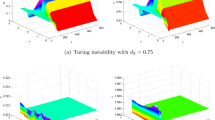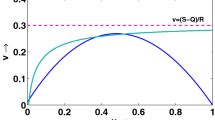Abstract
We discuss qualitative behavior of a discrete-time density-dependent predator-prey model. More precisely, we discuss the existence and uniqueness of positive steady-state, permanence, local and global behavior of unique positive equilibrium point and the rate of convergence of positive solutions that converge to the unique positive equilibrium point of this model. Moreover, it is also proved that system undergoes Neimark–Sacker bifurcation by using standard mathematical techniques of bifurcation theory. Numerical simulations are provided to illustrate theoretical discussion.








Similar content being viewed by others
References
Allen, L., Linda J.S.: An Introduction to Mathematical Biology. Prentice Hall, New York (2007)
Brauer, F., Castillo-Chavez, C.: Mathematical Models in Population Biology and Epidemiology. Springer, Berlin (2000)
Edelstein-Keshet, L.: Mathematical Models in Biology. McGraw-Hill, Philadelphia (1988)
Freedman, H.I.: Deterministic Mathematical Models in PopulationEcology, vol. 57 of Monographs and Textbooks in Pure and AppliedMathematics. Marcel Dekker, New York (1980)
Din, Q., Donchev, T.: Global character of a host-parasite model. Chaos Soliton Fract. 54, 1–7 (2013)
Din, Q.: Global stability of a population model. Chaos Soliton Fract. 59, 119–128 (2014)
Din, Q.: Global behavior of a plant-herbivore model. Adv. Differ. Equ. 2015, 119 (2015)
Din, Q.: Global behavior of a host-parasitoid model under the constant refuge effect. Appl. Math. Model. 40(4), 2815–2826 (2016)
Balreira, E.C., Elaydi, S., Luís, R.: Local stability implies global stability for the planar Ricker competition model. Discrete Contin. Dyn. Syst. Ser. B 19(2), 323–351 (2014)
Balreira, E.C., Elaydi, S., Luís, R.: Global dynamics of triangular maps. Nonlinear Anal. Theor. 104, 75–83 (2014)
Din, Q.: Dynamics of a discrete Lotka-Volterra model. Adv. Differ. Equ. 2013, 95 (2013)
Din, Q., Elsayed, E.M.: Stability analysis of a discrete ecological model. Comput. Ecol. Softw. 4(2), 89–103 (2014)
Din, Q., Ibrahim, T.F., Khan, K.A.: Behavior of a competitive system of second-order difference equations. Sci. World J. 2014, 9 (Article ID 283982)
Din, Q.: Stability analysis of a biological network. Netw Biol 4(3), 123–129 (2014)
Din, Q., Khan, K.A., Nosheen, A.: Stability analysis of a system of exponential difference equations. Discrete Dyn. Nat. Soc. 2014, 11 (Article ID 375890)
Din, Q.: Asymptotic behavior of an anti-competitive system of second-order difference equations. J. Egyptian Math. Soc. 24, 37–43 (2016)
Din, Q., Khan, M.A., Saeed, U.: Qualitative Behaviour of Generalised Beddington Model. Z. Naturforsch. A 71(2), 145–155 (2016)
Beddington, J.R., Free, C.A., Lawton, J.H.: Dynamic complexity in predator-prey models framed in difference equations. Nature 225, 58–60 (1975)
Elaydi, S.: Discrete chaos: with applications in science and engineering, 2nd edn. Chapman and Hall/CRC, Boca Raton (2008)
Kapçak, S., Ufuktepe, Ü., Elaydi, S.: Stability and invariant manifolds of a generalized Beddington host-parasitoid model. J. Biol. Dyn. 7(1), 233–253 (2013)
Yang, X.: Uniform persistence and periodic solutions for a discrete predatorprey system with delays. J. Math. Anal. Appl. 316, 161–177 (2006)
Kon, R., Takeuchi, Y.: Permanence of host-parasitoid systems. Nonlinear Anal. 47, 1383–1393 (2001)
Grove, E.A., Ladas, G.: Periodicities in Nonlinear Difference Equations. Chapman and Hall/CRC Press, Boca Raton (2004)
Pituk, M.: More on Poincare’s and Perron’s theorems for difference equations. J. Diff. Eq. App. 8, 201–216 (2002)
He, Z., Lai, X.: Bifurcation and chaotic behavior of a discrete-time predatorprey system. Nonlinear Anal. RWA 12, 403–417 (2011)
Liu, X., Xiao, D.: Complex dynamic behaviors of a discrete-time predatorprey system. Chaos Soliton Fract. 32, 80–94 (2007)
Jing, Z., Yang, J.: Bifurcation and chaos in discrete-time predatorprey system. Chaos Soliton Fract. 27, 259–277 (2006)
Acknowledgments
The author thanks the main editor and anonymous referees for their valuable comments and suggestions leading to improvement of this paper. This work was partially supported by the Higher Education Commission of Pakistan.
Author information
Authors and Affiliations
Corresponding author
Rights and permissions
About this article
Cite this article
Din, Q. Global Stability of Beddington Model. Qual. Theory Dyn. Syst. 16, 391–415 (2017). https://doi.org/10.1007/s12346-016-0197-9
Received:
Accepted:
Published:
Issue Date:
DOI: https://doi.org/10.1007/s12346-016-0197-9




